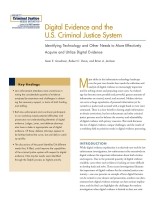| 来源类型 | Research Reports
|
| 规范类型 | 报告
|
| 来源ID | RR-890-NIJ
|
| Digital Evidence and the U.S. Criminal Justice System: Identifying Technology and Other Needs to More Effectively Acquire and Utilize Digital Evidence |
| Sean E. Goodison; Robert C. Davis; Brian A. Jackson
|
| 发表日期 | 2015
|
| 出版年 | 2015
|
| 页码 | 32
|
| 语种 | 英语
|
| 结论 |
Tactical Issues - Law enforcement attendees were unanimous in noting the considerable quantity of evidence analyzed by examiners and challenges in obtaining the necessary support, in terms of both funding and staffing.
Legal and Courtroom Issues - Both law enforcement and courtroom participants in our workshop noted potential difficulties with prosecutors not understanding elements of digital evidence. Judges, juries, and defense attorneys also have a stake in appropriate use of digital evidence. Of these, defense attorneys appear to be farthest behind the curve, but are likely to catch up quickly.
Prioritizing Digital Evidence Needs - The discussions of the panel identified 34 different needs that, if filled, could improve the capabilities of the criminal justice system with respect to digital evidence. Nine top-tier needs were identified through the Delphi process as highest priority.
|
| 摘要 |
- Educate prosecutors and judges. Including prosecuting attorneys in federal training programs would give them a greater understanding of what data is necessary, reducing data requests and workload for examiners. Expanding these programs to include judges would help give them a better foundation in issues surrounding this type of evidence.
- Enable first-responding patrol officers and detectives to be better prepared for incident scenes where digital evidence might be present. Training on digital evidence handling and preservation at the academy level and as a part of investigator training would promote better evidence preservation.
- Provide better prioritization and triage analysis of digital evidence given scarce resources. Departments do not have enough personnel to process the volume of digital evidence, resulting in large backlogs. This situation would be helped by providing tools for detectives in the field to triage evidence and developing guidelines for digital evidence examiners to better prioritize their workload.
- Develop regional models to make digital evidence analysis capability available to small departments. Small agencies, in particular, lack resources for effective collection and analysis of digital evidence. Partnerships with larger departments in the area could provide common resources available across regional agencies.
- Address concerns about maintaining the currency of training and technology available to digital forensic examiners. Digital devices and extraction tools change rapidly. Examiners need new tools and frequent training on new technologies to keep current.
|
| 主题 | Court Staffing and Funding
; Crime
; Criminal Justice
; Criminal Law
; Cyber and Data Sciences
; Law Enforcement
|
| URL | https://www.rand.org/pubs/research_reports/RR890.html
|
| 来源智库 | RAND Corporation (United States)
|
| 资源类型 | 智库出版物
|
| 条目标识符 | http://119.78.100.153/handle/2XGU8XDN/108087
|
推荐引用方式
GB/T 7714 |
Sean E. Goodison,Robert C. Davis,Brian A. Jackson. Digital Evidence and the U.S. Criminal Justice System: Identifying Technology and Other Needs to More Effectively Acquire and Utilize Digital Evidence. 2015.
|
|
文件名:
|
x1495316337526.jpg
|
|
格式:
|
JPEG
|

|
文件名:
|
RAND_RR890.pdf
|
|
格式:
|
Adobe PDF
|
除非特别说明,本系统中所有内容都受版权保护,并保留所有权利。